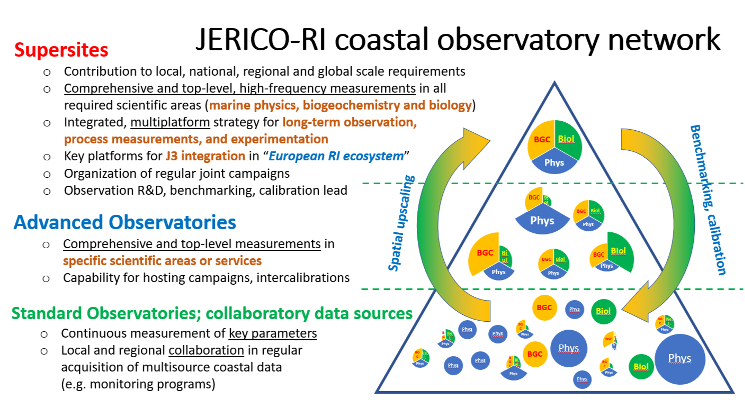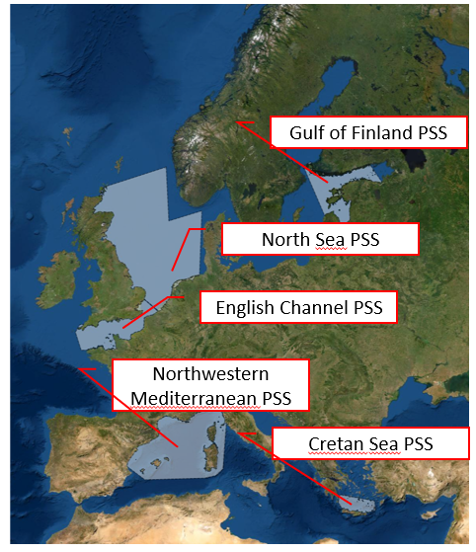The coastal observation platforms are scattered across the European coastline, largely based on national and regional initiatives, but to some extent also linked together for answering large-scale science questions. The JERICO-S3 project studies how these structures may be integrated further within the JERICO-RI, aiming to develop a network of harmonised and extensive observational capabilities for the European coastal seas.
The JERICO-RI envisions that the final coastal observation network will consist of three levels of observatories, Supersites, Advanced observatories and Standard observatories, which are differentiated by their capacities to provide observations:
- Supersites aim to provide holistic and top-level high-frequency measurements in all required scientific areas, using an integrated multiplatform strategy for long-term observations
- Advanced observatories provide comprehensive and top-level measurements in specific scientific areas or services.
- Standard observatories provide continuous measurements of some key parameters, often for local or regional needs.
All observational levels are needed, they have complementary roles and their differences are not always obvious.

Coastal supersites aim to improve national, regional, and pan-European collaboration for consistent observations, while simultaneously integrating solutions and best practices for organisational challenges. Supersites add value to existing observatory networks by overlooking the societal boundaries of nations, regions and institutes to observe the sea as the continuous entity that it is.
Within the coastal seas, because of the perpetual flux of the ecosystem, interactions between physical and biological dynamics do not take place in a fixed position but generally within the mesoscale – in horizontal scales up from tens to hundreds of kilometres – with embedded 3-D sub-mesoscale processes at various, nested spatiotemporal scales. A coastal sea Supersite must therefore encompass integrated and harmonised multiplatform measurements, the combination of which is able to yield adequate horizontal coverage and vertical resolution. Supersites in coastal seas are thus, in essence, regional and transnational, and a network of Supersites is envisioned in the future to connect the European coastal seas and jointly answer key environmental and societal challenges.
The aim of JERICO-S3 WP4, “Pilot Supersites for innovative coastal monitoring” is to provide a proof of concept for coastal Supersites, to study how the coastal observations are best integrated, for provision of sustained multidisciplinary observations. The Actions to be piloted include new institutional and organisational collaboration schemes, making the Pilot Supersite partnership work in concert and providing consistent regional data, services and products for various uses. The Pilot Supersites will interface with regional user communities, demonstrating the added value of integrated actions. Linking with other regional actions, especially with modelling and ocean colour communities and other Research Infrastructures (RIs), will provide new knowledge on the requirements for integrated coastal data and products. Pilot Supersites will also iterate how the linkages between Supersites and other observatories should be optimally built up for various coastal regions, and how communication between Supersites need to be structured, to meet pan-European requirements for high impact coastal observations.
During the JERICO-S3 project, 4 Pilot Supersites (PSSs) will be established and tested for a short period (approx. 2 years) across the European coastal seas to demonstrate how transnationally and transinstitutionally integrated multidisciplinary and multiplatform observations may add value to our ability to answer the multiple key scientific and social challenges the coastal ocean is facing. During the testing phase, a series of interlinked Actions will be implemented. The 4 PSSs are located in:
- the Gulf of Finland (GoF PSS),
- the North-Western Mediterranean (NW-MED PSS),
- the North Sea and the English Channel (NSEA and CHANNEL PSS),
- and the Cretan Sea (CRETAN PSS).

These sites will collect the first-hand experience on the organisational (trans-institutional, transnational etc.), data flow, and research challenges of the concept, in order to formulate an ambitious, but realistic framework for building a geographically representative array of integrated Supersites for the JERICO-RI, as an outcome of the JERICO-S3 project. This activity is done in parallel with another integrative action, as JERICO-S3 WP3 is working towards networking of existing coastal observing activities and initiatives at several other coastal regions (called Integrated Regional Sites, IRS). PSS and IRS actions will be streamlined throughout the JERICO-S3 lifetime and transfer of knowledge is done during joint workshops. It is expected that PSS networking actions will contribute to the development phase of JERICO-RI and the experiences will be directly communicated towards JERICO-DS -project.
The implementation plan for each PSS (Baltic Sea, Northwest Mediterranean, North Sea and the English Channel and Cretan Sea) contains a series with specific Actions identified for each PSS. These Actions are interlinked studies, each with coordinated partnership, objectives and description of activities. Each Action has identified the main results expected, the key users and links (internal within PSSs, within JERICO-S3 and with other communities) as well as a dissemination plan. The single Actions are linked together in many ways. Within the region, they provide insight on how the Supersites may operate and which parts of the integration need to be improved. Within various research topics (e.g. carbonate system, phytoplankton), various Actions will collaborate and share knowledge and practices, advancing the pan-European integration towards sustained and consistent observations. Towards other RIs and communities, together with other JERICO-S3 WPs, PSSs will progress the visibility of JERICO-RI actions and demonstrate their augmented capacities.
Further details of supersite concept, the JERICO-RI Pilot Supersites and Implementation Strategies are available in Deliverable Report 4.1: JERICO-S3 Pilot Supersite monitoring strategies.
Contact information
| Pilot Supersite | Contact(s) |
| Gulf of Finland | Jukka Seppala |
| North-West Mediterranean | Laurent Coppola |
| Cretan Sea | Constantin Frangoulis |
| North Sea and English Channel | Lisa Schneinder |
| – North Sea | Holger Brix, Klas Ove Möller |
| – English Channel | Alain Lefebvre |
